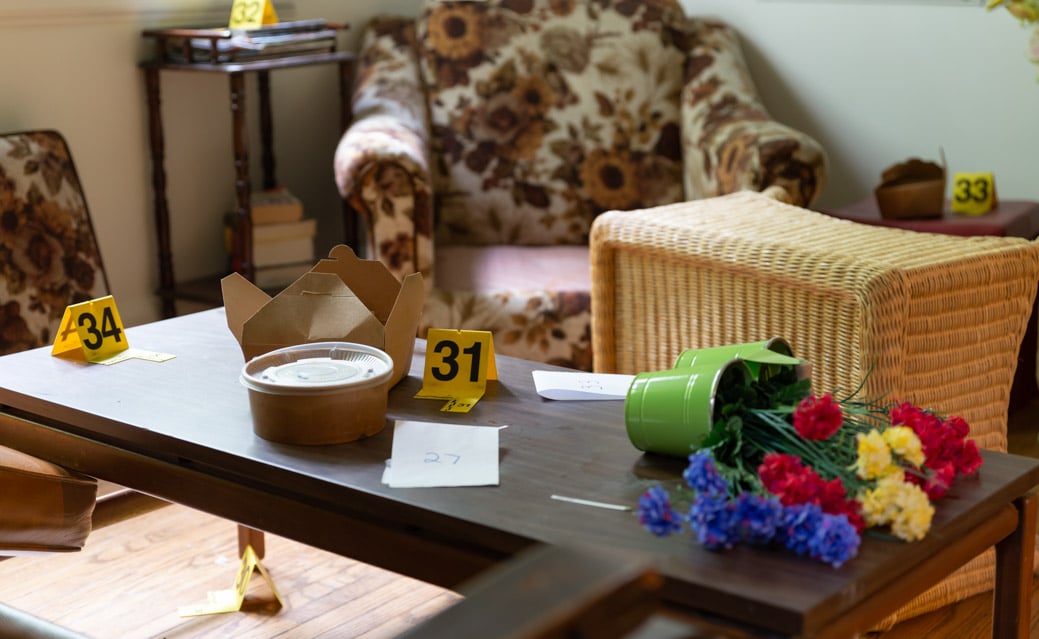Canada’s first crime scene investigation house lives on Principal’s Road
The house is home to mock crime scenes with trails of blood, bullet holes, and CPR dummies.
In the mid-1800s, Charlotte Mount Brock Schreiber, the owner of the grounds where the University of Toronto Mississauga (UTM) is currently located, commissioned to develop the land. While waiting for the completion of her main house, now known on campus as Lislehurst, Schreiber built a smaller cottage as a summer home, which she used as an art house. Over the last century, the little house on Principal’s Road has held many purposes for the university—including the residency house of David Blackwood. For some time, it was known as the Artists in Residency Cottage, where the university invited artists to stay periodically to work on their art. For the last 12 years, the house has undertaken the role of UTM’s Crime Scene Investigation House.
Used for students in the forensics program, the UTM Crime Scene House is the first of its kind in Canada. “A lot of other universities have houses like this now, but we were the first and UTM is really proud of that,” says Murray Clayton, the forensic science program officer and outreach coordinator at UTM. The house is an opportunity for students who want to experience crime scenes firsthand. Walking into a house with bloody footprints and bullet holes on the wall isn’t for everyone; the Crime Scene House at UTM helps students determine if forensics is really for them by setting up mock crime scenes.
However, the crime scene house isn’t exclusive to students. Occasionally, the local police will use it for training and research purposes. “Before Covid-19, we had police cadaver dogs doing recovery demos on human tissue,” says Clayton. “It was amazing to watch them work.”
The Toronto Police also use the house for Scene of Crime Officer training. Additionally, there are outreach programs in place for high school students to visit the Crime Scene House. The crime scenes presented to high school students aren’t as graphic as those presented to university students—it gives them the opportunity to be part of a fake crime scene and learn new investigative skills. Clayton recalls a time where a police constable was invited to the UTM Crime Scene House to help in the creation of a scene. A bullet was shot into the wall, and sheep’s blood was spattered onto one of the walls of a bedroom to mimic a gunshot to the head. Although the wall was plastered to cover the bullet hole, it remains stained with blood.
“Typically, the crime scenes [set up] in the house for class purposes are organized by our identification officer, Professor Wade Knapp,” continues Clayton. “He is a retired detective constable and teaches most of the major identification courses at UTM.”
In the identification courses, Professor Knapp uses his experience to create crime scenes that are typically more intense in nature. Such scenes may involve kidnapping, sexual assault, or even explosives and bomb-making, preparing students for what they might encounter in their careers. “For people who haven’t spent the last three or four years in forensics, some of these scenes may cause nightmares, but we want to make the scenes as close to what students might really see out there,” adds Clayton.
Ethics is an important topic of conversation when studying forensics. Out of respect for the families who have been affected by violent crimes, the crime scenes in the house will never be recreations of true crimes. “It’s important to note that all of our animal remains are ethically sourced,” says Clayton, explaining that they are donated to the university from a local farm. “These animals have either passed of natural causes or had to be euthanized due to sickness.” The blood used inside of the house is also ethically sourced, usually taken from sheep. Clayton highlights that the blood can be drawn from sheep without slaughtering the animal.
There are many features in the Crime Scene House that help students practice for real forensic work. “Several classes use these grounds so the way it’s used depends on the focus of the particular class,” explains Clayton. One of the rooms in the house is equipped with black-out curtains, where students practice using black lights and find invisible evidence in a crime scene. The second floor of the house contains storage rooms, which holds stamped evidence bags, fingerprint identification kits, and footwear analysis tools—all of which would be used to gather evidence at a real crime scene.
Although the rest of the house has been renovated to be fully functional, the basement has remained the same and is mostly used for kidnapping crime scene recreations.
Independent research opportunities through the Crime Scene House are also available to students who want to learn more about the forensic field. Behind the house rests a destroyed car, which was used to study the rates of charred decomposition over the winter and how investigators can identify and recover those remains. “We had taken the car to the Ontario Police College and essentially lit the car on fire,” says Clayton. The car was filled with pig carcasses before being ignited.
The UTM forensic and anthropological field schools also use the land all around UTM for their studies. Students are taught to identify the signs of decomposition and are tasked with scanning UTM’s property for decomposing animals hidden by the forensics team. “The decomposition process creates warmth,” explains Clayton. “It’s not unusual to see deer laying on top of [them].”Murray Clayton and colleagues are always eager to share information and provide tours of the Crime Scene House to students. To inquire on tours or to learn more about the house, reach out to Clayton via email at murray.clayton@utoronto.ca.

